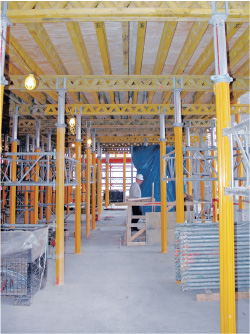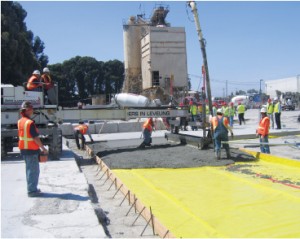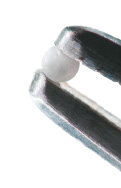Moisture Mitigation in Slabs: Learn how to reduce the amount of moisture in concrete floors
Retaining moisture in concrete is a good thing if the ultimate goal is a good curing condition, but what if you must install finished flooring materials requiring low concrete relative humidity (RH)? In this case, you’ll need your slab to dry out as soon as possible. But drying can be a slow process and contractors often find themselves in conflict with construction schedules. Under these schedule pressures, finished floor surfaces are sometimes installed when the RH of concrete is too high, frequently resulting in expensive testing, legal action, and repairs.
There are several ways to reduce moisture problems in floor slabs; In the design and construction phases, the development of concrete mixes that dry more quickly, installing subgrade vapor barriers that prevent moisture intrusion from below, and using finishing techniques that keep the surface open to allow slab drying. After construction, various techniques can be used to dry hardened concrete faster, and as a last resort, low permeability surface membranes can be used to seal in the moisture.
Better concrete mixes
Not all concrete dries at the same rate. To get a mix, that dries more quickly, consider the following.
Mix water. In general, the more water you put into a concrete mix the more must come out. This poses a special problem for lightweight concrete because the aggregate must be saturated before mixing. On the other hand, concrete with a low water-cement ratio has fewer capillaries—the small canals that transport moisture to the surface of a slab. The capillaries that form are filled largely with cement hydration product within the first couple days, making them discontinuous. This dense concrete dries out much more slowly, although it has less free water to start with.
Concrete with a high water-cement ratio produces more capillaries, making it easier for moisture to move through a slab quickly, but more water must leave, which also takes time. Slab drying time is dependent on the water-cement ratio and the resulting capillary structure.
Self-desiccation. Kevin MacDonald, vice president of engineering services for Cemstone, Mendota Heights, Minn., says water in concrete becomes an accounting problem—when designing a mix you must know how much water is present and where it all goes. Some is consumed by the cement hydration process, some escapes into the air, some may be absorbed by the ground (if there is no vapor retarder), and some resides in the coarse aggregate. To reduce drying time, mix water must either leave a slab or be chemically or physically bound as quickly as possible.

Both slabs on ground and elevated slabs need to dry out before installation of mositure-sensitive flooring. Credit: Joe Nasvik
The RH of low water-cement concrete can be reduced by self-desiccation, meaning that a higher percentage of its mix water is used to make cement hydrate during its initial curing. MacDonald says a low level of silica fume, a rapidly hydrating material, can be added to a mix to increase the amount of self-desiccation. In his experience, dosage rates from 2% to 4% can reduce drying time by 50% without affecting the finishability of the concrete. He says silica fume pushes individual cement grains apart, acting like a water reducer and then rapidly hydrating to form calcium silicate hydrate, consuming water to complete its crystal structure. As a result, water that otherwise would have to move through a slab and escape is locked permanently into the crystalline structure of the paste. Another technique for self-dessication is to increase the amount of cementitious content of a mix in order to consume more water during hydration. But the side effects of this approach usually outweigh the gains due to increased shrinkage and cracking potential–and higher cost.

This self-dessicating concrete exterior placement was made on a vapor barrier to prevent the very low water content from being sucked up by the subgrade. Credit: U.S. Concrete
New proprietary mixes will soon be available that are easy to place and that purportedly dry in as little as 30 days. U.S. Concrete has a product called Aridus that has seen some limited use in California. These materials could end up solving this problem, although there will certainly be a price tag involved.
Replacing porous aggregates. The primary advantage of using lightweight aggregate concrete for abovegrade floors in buildings is to reduce unit weight. Internal curing also is a positive effect of saturated lightweight aggregate. The drawback, though, is the long time needed to achieve specified RHs in order to install finished floor products, such as sheet vinyl, wood, and carpet. The drying process, according to Tom Nordeen, vice president of Power Construction, Schaumburg, Ill., can take a year or longer in some cases.

The lightweight synthetic particle shown here is about 1⁄16 in. in diameter and replaces some of the aggregate in concrete. Credit: Syntheon
One way to shorten this drying time, according to MacDonald, is to replace lightweight aggregate with lightweight synthetic particles. Luke Kimble, business development manager for Syntheon, maker of Elemix (synthetic lightweight beads), Moon Town- ship, Pa., says its small Polymer beads have negligible water absorption and concrete made with them can be easily pumped at water-cement ratios of 0.40. Drying rates for concrete made with Elemix closely match rates of normal weight concrete, though quicker drying can be achieved.
Finishing considerations
The extent to which concrete is finished directly affects how fast moisture can move through a slab’s surface. Permeability studies conducted by the CTLGroup, Skokie, Ill., during CC’s warehouse floor study examined a slab finished by ride-on trowels that resulted in a 1⁄8 inch-thick densified layer. This hard troweled finish inhibited moisture vapor emission as much as a curing compound. After two years, the internal RH was still above 95%. (See “Discovering the Unexpected” in the March 2011 issue.) In that same study, a hand-troweled floor had a much more permeable surface. Scott Tarr, Concrete Engineering Specialists, recommends a lightly troweled surface for floors that need to dry out for moisture-sensitive floor coverings, perhaps finished with plastic trowel blades. ACI 302.2, Guide for Concrete Slabs that Receive Moisture-Sensitive Flooring Materials, recommends that the contractor consider the surface preparation that will be used prior to installation of the flooring—shotblasting makes the original surface finish moot. When speedy moisture movement through a slab surface is important, densely troweled floor finishes can be a detriment.
Vapor retarding membranes
Subgrade vapor retarding membranes are routinely specified and should be installed beneath all interior slabs on ground. When properly installed, they entirely eliminate moisture and radon gas movement from the ground through the concrete and into enclosed building spaces. As Peter Craig, Concrete Constructives, Greene, Maine, implores, always take the ground out of play by installing a quality vapor barrier for any interior floor. Mat Blasdel, technical director for vapor barrier manufacturer Stego, San Clemente, Calif., says that slab drying times are initially a little longer with a barrier but drying time is reduced by preventing ground moistrure from being added to the system. Without a vapor barrier, a slab on ground will never dry out.
Post-installation drying applications
Nordeen’s company specializes in hospital and health care construction. Floor coverings include carpet, tile, and sheet vinyl—vinyl having the most stringent slab moisture requirements. He says they’ve tried several ways to dry out floors in order to maintain construction schedules, with reducing ambient RH and increasing room temperature being the fundamental approaches. “We discovered that enclosing a structure as quickly as possible is money well spent,” he says. “Dehumidifying or heating areas as much as 100 & 176F is expensive and doesn’t significantly reduce a slab’s RH.”
Nordeen adds that improved adhesives for carpet and tile enable manufacturers to tolerate higher RH levels in concrete floors but this isn’t the case for sheet vinyl or rubber floor coverings—the products of choice for hospitals because it’s easier to control bacterial growth. Adhesives for sheet vinyl that tolerate higher RH levels are beginning to become available, although they are often cement-based products that are very difficult to remove for flooring replacement.
Surface membranes
When the moisture content in a slab is too high, contractors can install surface membranes to inhibit moisture emissions and proceed with the installation of finished floor products. Several manufacturers make one- or two-part epoxy-based products specifically designed as surface membrane vapor retarders. Craig, however, cautions that these systems can easily fail if not installed properly. To protect yourself as a contractor in these situations, Victor Klemaske, T.B. Penick, San Diego, says to use the membrane recommended by the flooring manufacturer.
Bruce Newbrough, director of application development for ARDEX Americas, Aliquippa, Pa., says, “The primary function for surface membranes is twofold: create a sufficient bond to concrete to remain in place and slow down the movement of moisture through the system. The bond is much greater than the moisture vapor pressure that develops. These highly cross-linked epoxies work because they have very low perm ratings; less than the products installed on top of them.”
Manufacturers sell and warrant epoxy systems rated for different slab moisture contents. Newbrough says their products can be installed on 98% RH concrete.

ICRI’s CSP-2 (left) and CSP-3 (right) profiles shown are the most commonly specified surfaces for surface membrane systems. Credit: Joe Nasvik
Leigh Hightower, manager of technical services for Mapei, Deerfield Beach, Fla., says they have similar products but require moisture testing according to ASTM F2170 for relative humidity or ASTM F1869 for MVER. Both standards require three measurements for the first 1000 square feet and one additional test for each 1000 square feet thereafter.
Before surface membranes can be installed, the concrete must be profiled to create a bondable surface. Specifications usually refer to the International Concrete Repair Institute’s (ICRI) CSP profile guidelines. Ardex requires a CSP 3 minimum profile and Mapei a CSP 2. Both profiles can be achieved by bead-blasting, diamond grinding with 40-grit metal-bond pads, or scarifying.
Installing these 100% epoxy products requires manufacturer-certified contractors. Hightower says they provide training for their network of contractors and will only sell product to those they certify. “Our warranty is based on contractors properly installing our product,” he adds. Depending on the product selected for an application, Mapei membranes can range from 10 to 18 mils in thickness, leaving floors with a shiny look.
Surface membrane systems require a cement-based underlayment applied over the surface of the epoxy. It can be placed by trowel or as a self-leveling underlay- ment as thick as 1⁄4 inch. The primary purpose is to provide a good bonding surface for the overlying flooring and a space for moisture from the water-based adhesives to escape.
What should you do?
Drying out concrete slabs in timely fashion costs money—an actual cost not usually reflected in a bid. If the only avenue left to you is the application of a surface membrane, plan to spend as much as $6 per square foot. Noreen concedes that his suggestion to start the drying process by enclosing an area as soon as possible after concrete placement often involves overtime pay—money he thinks is well spent. Post-installation drying out techniques, such as adding heat or dehumidification, isn’t cheap either. Maybe developing mixes designed to self-desiccate will end up being the most reasonable price, along with providing the least amount of finish to the surface.
Whatever you do, this is a key subject to discuss in the preconstruction meeting.
Reprinted, with permission, from the Concrete Construction October 2011 Issue